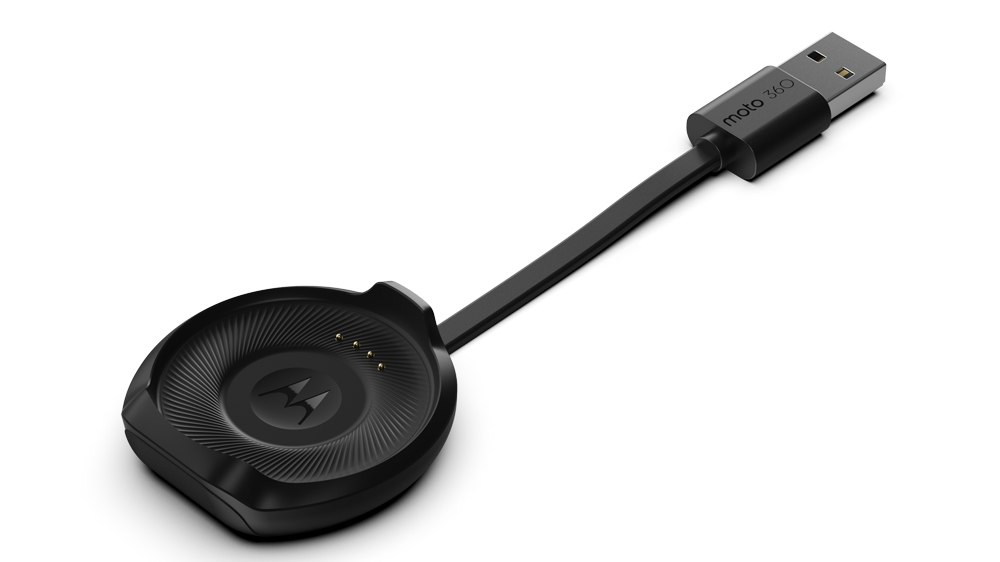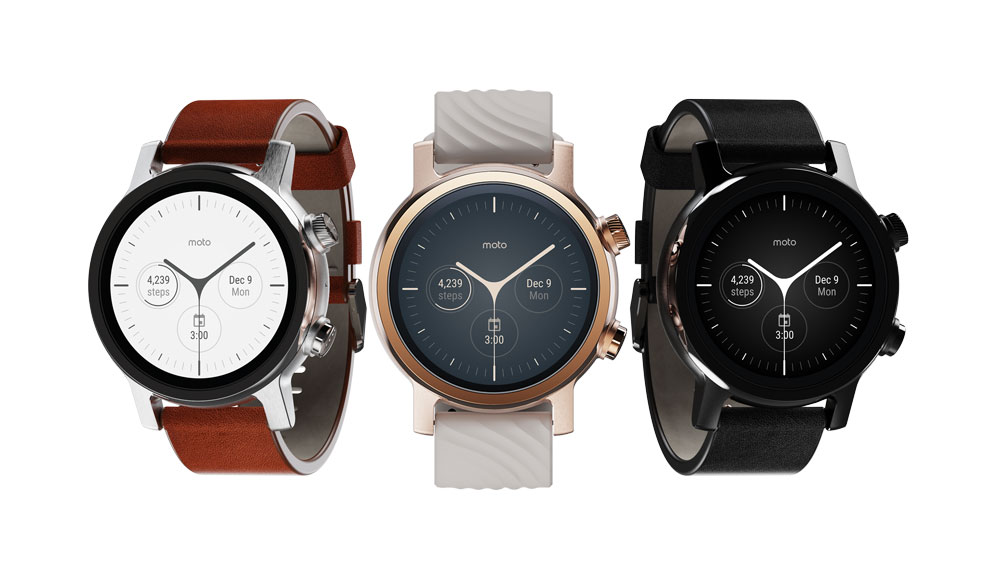Our Verdict
Beautiful smartwatch whose reliance on touchscreen controls and limited battery life let it down as a fitness tracker.
For
- Stylish looks
- Excellent screen
- Wide selection of apps
- Impressive smart features
Against
- Fiddly touchscreen controls
- Poor battery life
- No swim tracking
You can trust Coach
The third-generation Moto 360 is arguably the best-looking wearable I’ve ever had on my wrist. However, I wouldn’t recommend it for anyone who values fitness above everything else.
You can replace the bundled Google Fit app with something better – and you should – but the watch is still hamstrung by a reliance on touchscreen controls and limited battery life. That’s a pity, because in every other respect the latest Moto 360 is a brilliant smartwatch that’s right up there with its rivals. Close, but no cigar.
Buy from Moto | £299.99 (currently reduced to £199.99)
Moto 360 In-Depth
You may dimly remember the Moto 360, first released in 2014. Well, forget it, because after a second-generation release in 2015, Motorola discontinued the watch and left the wearables race to the Apples and Samsungs of this world. The new Moto 360 is the product of a company called eBuyNow which has a five-year licensing deal to use the brand and logo.
With this watch, eBuyNow has made a promising start. The screen is a full-circle AMOLED number with an always-on display and a promised day-long battery life. It also includes 8GB of internal storage and NFC for contactless payments, meaning you can leave your phone behind and still take the bus to your local parkrun (once they’re up and running again, of course). Once there, the Moto 360’s built-in GPS, heart rate monitor and accelerometer will come in handy.
Although there are two buttons, the watch is mainly operated via the touchscreen, which can be a bit fiddly because it requires swipes up, down, left and right. The top button brings up a list of apps, while the bottom one can be paired to any one app you want. That’s nice and all, but it gets a bit fiddly when using any watch app, because one press of either button will switch to something else.
Sign up for workout ideas, training advice, reviews of the latest gear and more.
Smart Features On The Moto 360

Wear OS isn’t as popular as it used to be: Samsung and Huawei abandoned it, while Apple and Fitbit never used it at all. That’s a pity, because it’s matured into something that’s very usable.
All the smart features you’d expect are present and correct. Notifications come through with a gentle buzz, but only if you’re not interacting with your phone at the time to avoid doubling up. You can receive notifications from pretty much anything, and you can whitelist or blacklist apps from your phone to customise the experience to your liking.
The 1.2in AMOLED 390x390 screen really comes into its own here. Not only is everything crisply presented, but you’ll even get WhatsApp photos appearing on your wrist. True, it’s a tiny version, but you can at least spot whether it’s a photo worth getting your phone out for or a meme that can be filed away for later (or never).
Finally, since this is a Google product in 2020, Google Assistant is built in. That means you can tap an onscreen button and then ask your watch a question – though because there’s no speaker on it, you’ll have to read the response, making it better suited to one-word answers or setting alarms (your wrist will buzz when the timer is up.)
Tracking Activity With The Moto 360
As on any Wear OS smartwatch, Google apps are front and centre, and for fitness this means Google Fit. For the basics, it’s not bad: the Moto 360 is always tracking your steps and can be set to intermittently test your heart rate throughout the day to give you an idea of how your resting heart rate improves over time – a key metric for measuring improvements to your overall fitness.
It will also give you an estimate of calorie consumption for the day based on your height, weight and activity, assuming you’re happy to share these metrics with Google. But best of all for casual fitness fans is Google’s system of measuring things in “heart points”, which is a simple way to ensure you’re staying as active as the NHS and WHO recommends. You get awarded one heart point for every minute of activity you do with the aim of amassing 150 each week. It’s a measure that has become increasingly popular, with Garmin tracking it as intensity minutes, and Fitbit putting it front and centre when it launched the Charge 4, branded as Active Zone Minutes.
While experienced runners and gym enthusiasts might scoff at the simplicity of it, it certainly has its merits, providing a clear way for people to see if they’re reaching key activity targets.
Running With The Moto 360

The Moto 360 begins to fall down a bit when it comes to running. For no reason at all, the default Google Fit app insists on piggybacking off your phone’s GPS rather than using the perfectly good sensor built into the watch.
This might be for sensible battery-preserving reasons, but it raises a fairly obvious question: why waste money putting a GPS sensor in a watch if you’re not going to use it? On top of this, I’ve had plenty of phones which provide deeply misleading GPS data because of aggressive battery-saving settings when the screen is locked. In other words, if you use this you’re at the mercy of your phone’s GPS, which can be bad news.
On top of that, Google Fit’s running interface isn’t hugely helpful. It tells you the basics – time, distance (to the nearest 0.1km) and average pace – at a glance. While you can scroll down to see more, the touchscreen is unreliable if it’s raining or you’re sweating. For someone used to the less flashy but more dependable world of Garmin, it was quite the culture shock.
Of course, there are other run tracking options on the Wear OS app store, including all the heavy hitters: Strava, Runtastic, Runkeeper, Endomondo and Map My Run. But even so, I’m yet to find one with my preferred combination of metrics on a single screen.
Still, these do use the built-in GPS, which makes a big improvement in terms of accuracy. A run that measured 5km on my Garmin Forerunner 245 came in at 4.9km when tracked using the Strava app on the Moto 360. I’d recommend anybody using the Moto 360 make the switch, even if the complaints about the touchscreen scrolling remain.
See related
Working Out With The Moto 360
At a glance, the Moto 360 appears to be the Holy Grail of fitness trackers, with nearly 100 sports listed within Google Fit covering everything from fencing to flossing (the dance, not the dental care).
If you’re wondering how the watch can accurately track, say, curling, the answer is that it can’t really. For most of these exercises, you’re going to get just time and heart rate tracking to estimate how you’ve done. Even those that use GPS still hit the limitation I mentioned before: Google Fit wants to piggyback off your phone, and not use the built-in sensor – and you probably don’t want to take your phone windsurfing for obvious reasons.
You might think that criticising a watch for offering too many exercises – even if it doesn’t provide useful insights – is a bit harsh, but bear in mind that you have to scroll through all of these to find the one that you want. Yes, your most recent workouts appear at the top, but it’s still a bit much if you’re just trying to complete a gym circuit.
The maker says the Moto 360 is “designed for casual swimming and water activity”. This is confusing for two reasons: firstly because it’s rated at 3ATM water-resistant, and by most people’s definition that means it’s not safe for swimming; and secondly because swimming is bizarrely one of the few sports not listed, despite paragliding, frisbee and sledding all making the cut. Sure, you can download a swimming app from the Wear OS store, but considering the 3ATM rating, I’d probably give it a miss.
Battery Life On The Moto 360
Normally at this point we’d look at sleep tracking, but the Moto 360 doesn’t have any. Yes, you could download Sleep as Android from the Wear OS app store, but in truth you may end up disappointed. Why? Well, the battery life on the Moto 360 is pretty poor.
While it’s nowhere near as bad as it was on the first-generation Moto 360, the 355mAh battery isn’t going to last much longer than a day – less if you use the built-in GPS, which used up around 15% of a full charge on a half-hour run.
Realistically, then, you’ll be taking it off at night to charge, and charging is very much a “one step forwards, two steps back” experience.

On the plus side, the watch can now fast charge from empty to 100% battery in an hour. The downside is this has been achieved by ditching wireless charging in favour of a bespoke cradle on which the watch must be docked. Suffice it to say that nobody in your office will have a spare when you run out of juice, and given a number of phones now support reverse wireless charging, it’s disappointing that the new-look Moto 360 can’t take advantage of this in a pinch.
Where Can I Wear The Moto 360 Without People Laughing At Me?

Absolutely anywhere, I’d say. Not only is the Moto 360’s body stylish, but the company has provided two straps in the box: a silicone one for when you’re working up a sweat, and a leather one for the rest of the time. It’s such a sensible move that it’s amazing no other company has done this before.
I don’t want to overstate it: the Moto 360 is still chunky by traditional timepiece standards, but – if you have big enough wrists to carry it off – it looks great. This is probably the Moto 360’s strongest feature.
Should You Buy Something Else?
The new Moto 360 is a lovely smartwatch, but as a sporty wearable it mostly falls flat. While I applaud having an easily changeable sporty strap in the box, the actual experience of using it for exercise isn’t great – mainly thanks to the overreliance on the touchscreen and weak battery life.
So while the Moto 360 is unquestionably one of the best-looking smartwatches you can buy, there are better options at the £300 price point. For sports enthusiasts, the Garmin Venu isn’t quite as good-looking and Garmin Pay is virtually useless in the UK, but it’s far better as a fitness tracker. Another solid alternative is the Samsung Galaxy Watch Active 2, which is both great-looking and likely to see a tempting price cut now that the company has unveiled the new Galaxy Watch 3.
If you’re prepared to pay more for a Wear OS smartwatch that does a better job of sports tracking, consider the Suunto 7 at £429. Although it runs Wear OS it’s Suunto, veteran maker of GPS multisport watches, that handles the sports tracking and adds excellent bespoke map functionality.
Alan is a freelance tech journalist and mostly covers fitness trackers for Coach.
Alan was not what you would call a big fitness guy growing up, but has been radicalised by parkrun and taken up running in a big way. Although nowhere near podium at races, as a late starter he does at least know that he can still get faster. Alan has written for ShortList, Tom’s Guide, Trusted Reviews and Expert Reviews, among others.


